DECLARATION OF INDEPENDENCE]. In Congress, July 4, 1776. The Unanimous Declaration of the Thirteen United States of America. Washington: W. I. Stone for the Department of State, 4 July 1823. Broadside, folio (776 x 660mm), ON PAPER, (no folds, minor toning to margins, three minor repaired tears along the bottom edge, barely perceptible repaired tears at left-hand side, not affecting the signatures, small stain at the right edge of William Williams' signature, square areas at left and right on verso slightly lighter than surrounding paper; minor conservation by Susan Rogers of the Conservation Department of the Huntington Library). Housed in an acid-free mat. "LIFE, LIBERTY AND THE PURSUIT OF HAPPINESS" Brigham Young's copy of the Stone-engraved Declaration of Independence: one of only six known proofs executed on paper. These six paper printings, on the same wove paper, are now believed to comprise trial proofs struck from the original plate before Stone printed the main edition of 201 copies ordered by Congress for the 50th anniversary of the Declaration. Congress stipulated that the 201 copies comprising that edition, intended for presentation purposes, be printed on large sheets of fine-quality vellum. Laboriously prepared from individual whole skins, vellum was extremely expensive, for that reason, it is likely that when proofing his engraving, Stone would pull proofs on paper. At a later date, Stone's 1823 imprint (engraved in very small letters at the top, on either side of the words "In Congress"), was carefully burnished from the plate. Stone's original copperplate – retained by the Department of State--was re-used by Peter Force to print copies on thin rice paper for inclusion in his multi-volume American Archives, which appeared in 1848; these have no imprint at the top, but carry an abbreviated imprint ("J. W. Stone sc. Washington") added in the blank area at lower left. Stone's meticulously traced and engraved facsimile of this, America's founding manifesto, is the most accurate of existing facsimiles and the only one officially authorized by Congress. In 1820 – roughly forty years after the Declaration of Independence was adopted by Congress and signed in Philadelphia by 56 delegates – Secretary of State John Quincy Adams, commissioned William J. Stone to execute a full-scale facsimile of the Declaration which itself had badly deteriorated in the intervening years. It reportedly took Stone three full years to complete his engraving work on the copper plate. The copies were distributed as follows: Two each to the President and Vice President, two to former President Madison, 20 copies to the two Houses of Congress, two to the Marquis de Lafayette, twelve copies for the departments of government, two copies for each of the three surviving Signers (Jefferson, Charles Carroll, John Adams two for the President's house, one each to the Governors of the States and Territories, one copy to the Councils of the Territories, and the remaining copies to the various universities and colleges of the United States. According to the most authoritative census, in 1991, there were some 31 surviving parchment copies, of which 19 were in institutions. John Bidwell, "Some Broadside Editions of the Declaration of Independence," in Proceedings of the American Antiquarian Society , vol.98, no 7; W.R. Coleman, "Counting the Stones-A Census of the Stone Facsimiles of the Declaration of Independence," in Manuscripts , vol.43 (1991), no.2, pp.97-105. According to Young Family tradition, Daniel Webster presented the present example to Brigham Young, the newly appointed Governor of the Territory of Utah on 25 March 1851. Apparently, the Secretary of State had included the document along with a shipment of documents and books "to which, under various acts of Congress the Territory of Utah is entitled" ( Domestic Letters of the Department of State , 38:540). It is quite probable the present example was the one sent by Webster. According
DECLARATION OF INDEPENDENCE]. In Congress, July 4, 1776. The Unanimous Declaration of the Thirteen United States of America. Washington: W. I. Stone for the Department of State, 4 July 1823. Broadside, folio (776 x 660mm), ON PAPER, (no folds, minor toning to margins, three minor repaired tears along the bottom edge, barely perceptible repaired tears at left-hand side, not affecting the signatures, small stain at the right edge of William Williams' signature, square areas at left and right on verso slightly lighter than surrounding paper; minor conservation by Susan Rogers of the Conservation Department of the Huntington Library). Housed in an acid-free mat. "LIFE, LIBERTY AND THE PURSUIT OF HAPPINESS" Brigham Young's copy of the Stone-engraved Declaration of Independence: one of only six known proofs executed on paper. These six paper printings, on the same wove paper, are now believed to comprise trial proofs struck from the original plate before Stone printed the main edition of 201 copies ordered by Congress for the 50th anniversary of the Declaration. Congress stipulated that the 201 copies comprising that edition, intended for presentation purposes, be printed on large sheets of fine-quality vellum. Laboriously prepared from individual whole skins, vellum was extremely expensive, for that reason, it is likely that when proofing his engraving, Stone would pull proofs on paper. At a later date, Stone's 1823 imprint (engraved in very small letters at the top, on either side of the words "In Congress"), was carefully burnished from the plate. Stone's original copperplate – retained by the Department of State--was re-used by Peter Force to print copies on thin rice paper for inclusion in his multi-volume American Archives, which appeared in 1848; these have no imprint at the top, but carry an abbreviated imprint ("J. W. Stone sc. Washington") added in the blank area at lower left. Stone's meticulously traced and engraved facsimile of this, America's founding manifesto, is the most accurate of existing facsimiles and the only one officially authorized by Congress. In 1820 – roughly forty years after the Declaration of Independence was adopted by Congress and signed in Philadelphia by 56 delegates – Secretary of State John Quincy Adams, commissioned William J. Stone to execute a full-scale facsimile of the Declaration which itself had badly deteriorated in the intervening years. It reportedly took Stone three full years to complete his engraving work on the copper plate. The copies were distributed as follows: Two each to the President and Vice President, two to former President Madison, 20 copies to the two Houses of Congress, two to the Marquis de Lafayette, twelve copies for the departments of government, two copies for each of the three surviving Signers (Jefferson, Charles Carroll, John Adams two for the President's house, one each to the Governors of the States and Territories, one copy to the Councils of the Territories, and the remaining copies to the various universities and colleges of the United States. According to the most authoritative census, in 1991, there were some 31 surviving parchment copies, of which 19 were in institutions. John Bidwell, "Some Broadside Editions of the Declaration of Independence," in Proceedings of the American Antiquarian Society , vol.98, no 7; W.R. Coleman, "Counting the Stones-A Census of the Stone Facsimiles of the Declaration of Independence," in Manuscripts , vol.43 (1991), no.2, pp.97-105. According to Young Family tradition, Daniel Webster presented the present example to Brigham Young, the newly appointed Governor of the Territory of Utah on 25 March 1851. Apparently, the Secretary of State had included the document along with a shipment of documents and books "to which, under various acts of Congress the Territory of Utah is entitled" ( Domestic Letters of the Department of State , 38:540). It is quite probable the present example was the one sent by Webster. According
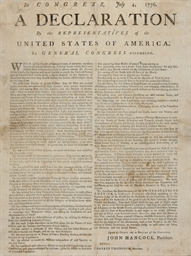
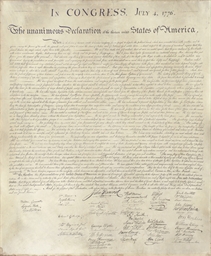
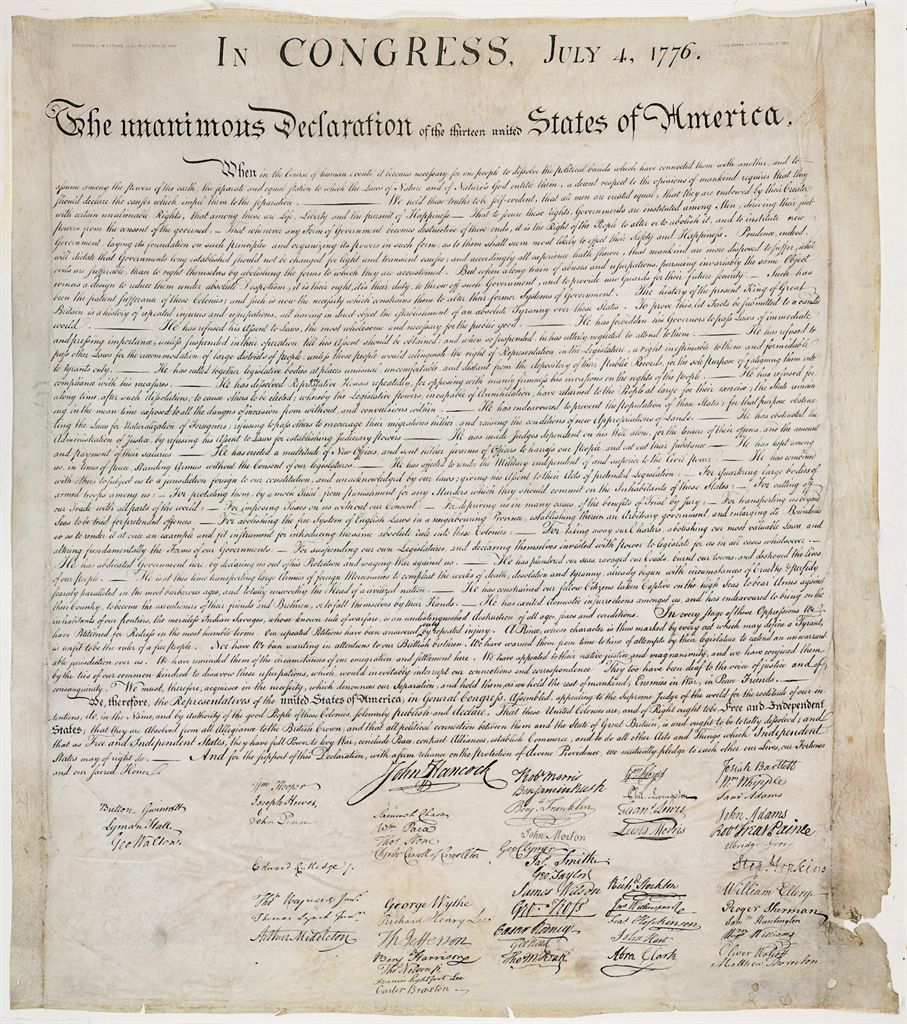
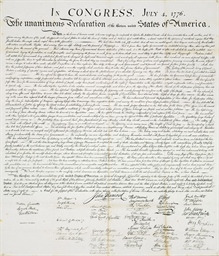
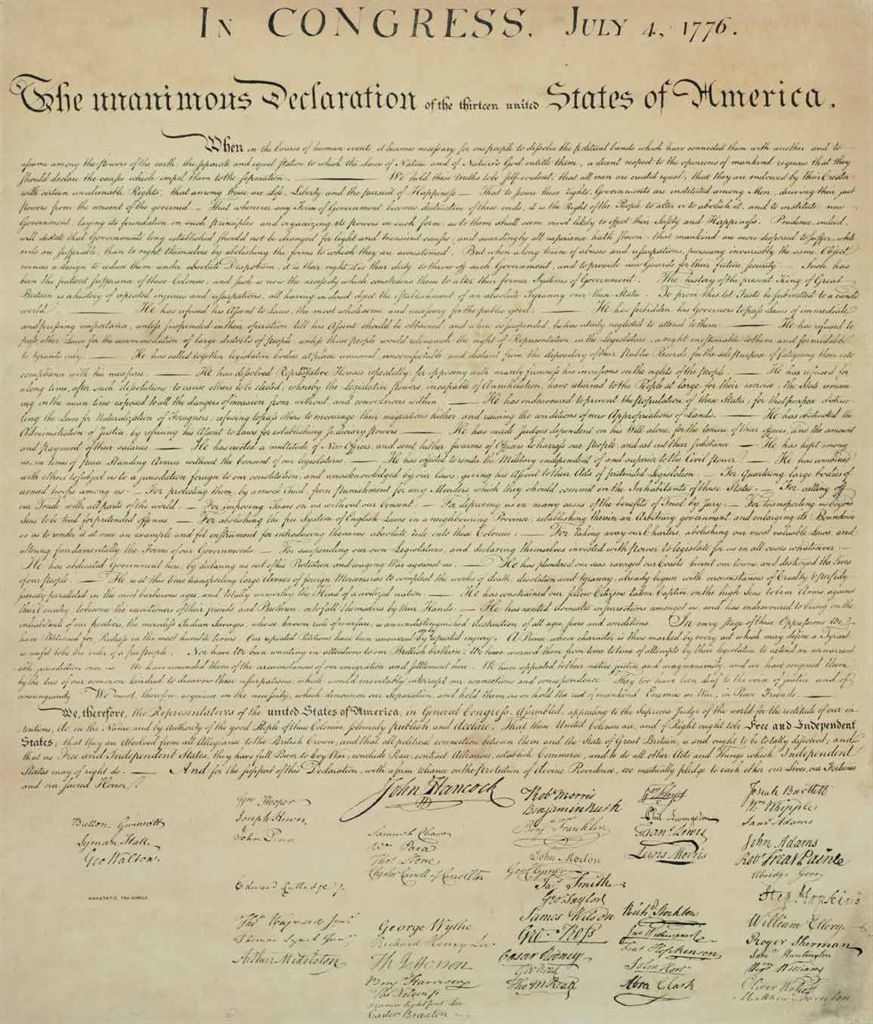
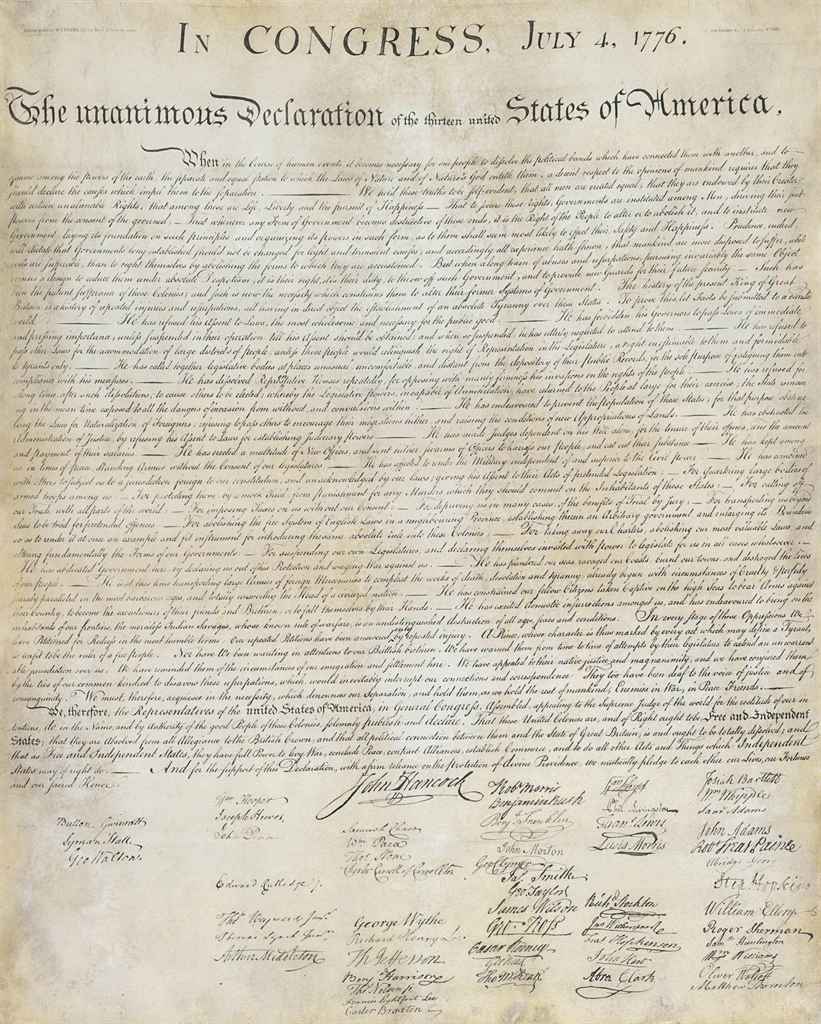
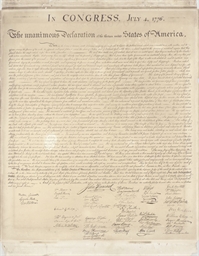
.jpg)
.jpg)
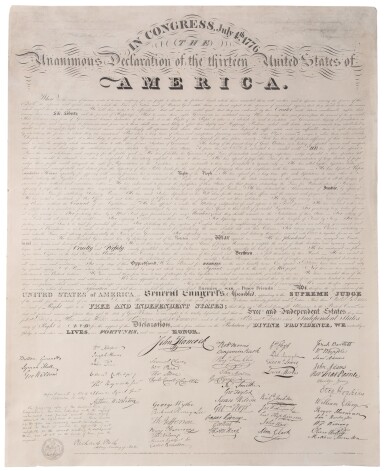

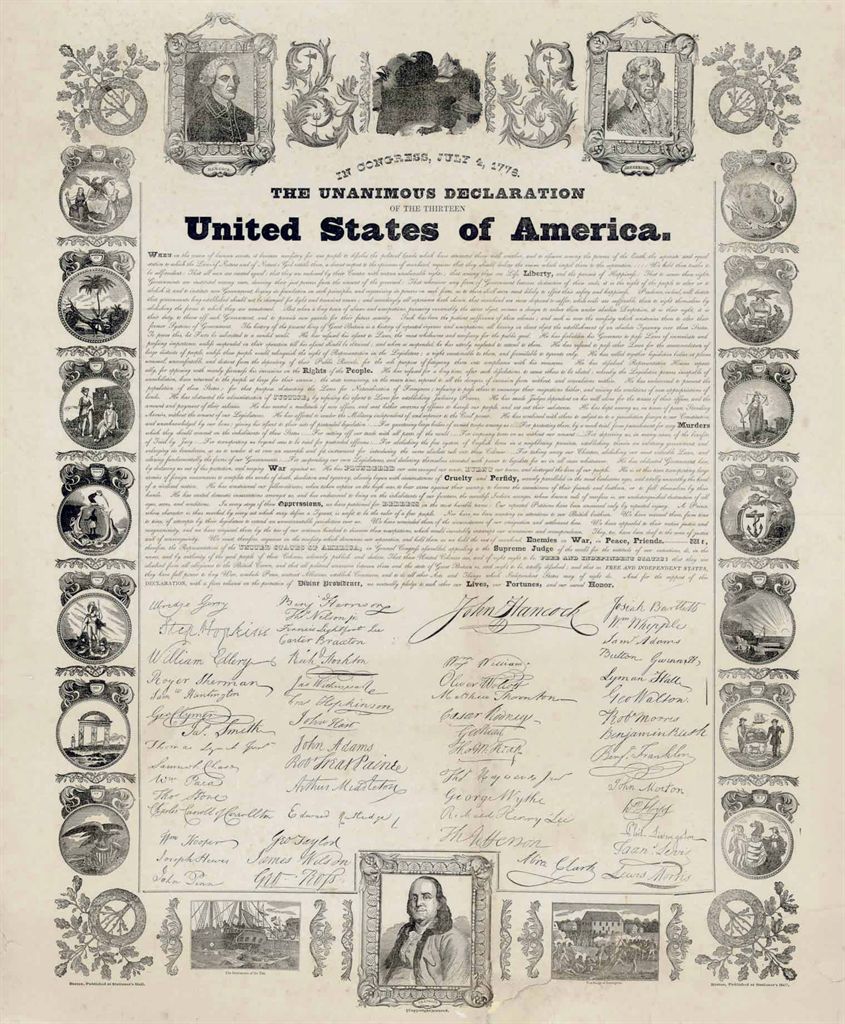
.jpg)
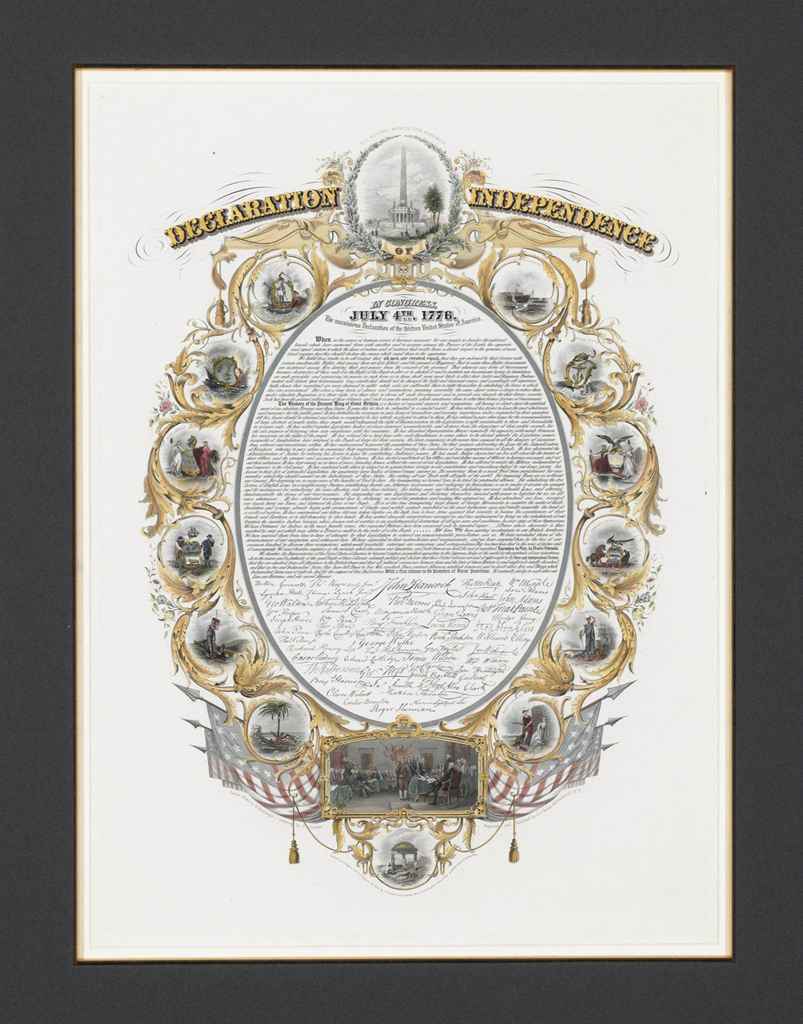

Testen Sie LotSearch und seine Premium-Features 7 Tage - ohne Kosten!
Lassen Sie sich automatisch über neue Objekte in kommenden Auktionen benachrichtigen.
Suchauftrag anlegen